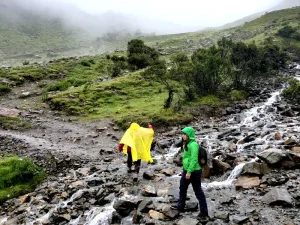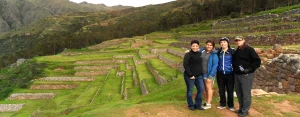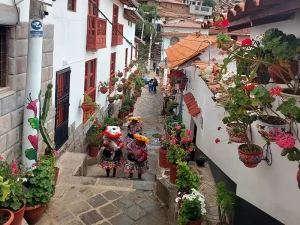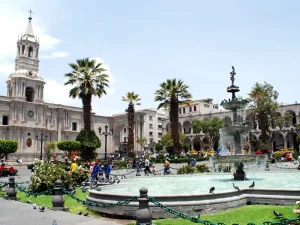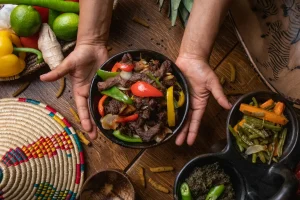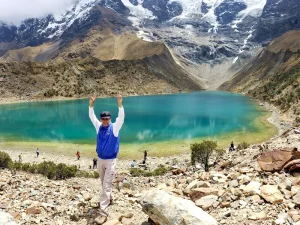The mist was so thick that morning on the Salkantay Trail that I could barely see my boots. My small group of travelers, a mix of excitement and fatigue on their faces, huddled together as we began our ascent. With each step, the air grew thinner and colder. And then, as if a curtain were being drawn, the q’espera—the Andean mist—suddenly vanished. The sun erupted, illuminating the colossal, glacier-clad peak of Mount Salkantay before us. A collective gasp swept through the group. One of them, Sarah from Canada, had tears in her eyes. “We could have missed this,” she whispered. “If we’d come a month later, our guide said the sky is never this clear. We timed it perfectly.”
That moment cemented a truth I’ve learned over a lifetime of exploring Peru: timing is everything. The “best” time to visit isn’t just about avoiding rain; it’s about aligning your journey with the rhythm of the land, the pulse of the festivals, and the unique magic each season offers. As your native guide, I’m here to share not just weather charts, but the soul of each season. So, let’s find your perfect time to experience the land of the Incas.
A Journey Through Time and Seasons
Imagine standing in front of the ancient citadel of Machu Picchu, watching the morning mist slowly dissolve as golden sunlight reveals the breathtaking stonework. Or picture yourself wandering through Cusco’s cobblestone streets during Inti Raymi, the grand Festival of the Sun, with colorful parades and Andean music echoing through the mountains.
Peru is not just a destination—it’s a living story where every season brings a different chapter. As a local guide born and raised in the Andes, I can tell you that choosing when to visit Peru is one of the most important decisions travelers make. Each month offers unique experiences, shaped by our geography, climate, and traditions.
Let’s explore together the best time to visit Peru, month by month, season by season, so you can plan your adventure with confidence and excitement.
Why Timing Your Trip to Peru Matters
Peru is a country of dramatic geographical contrasts—the arid coast, the towering Andes, and the vast Amazon rainforest. This means that when it’s sunny on the coast, it might be the peak of the rainy season in the mountains. The “best” time entirely depends on what you want to experience, where you want to go, and what kind of traveler you are.
Do you dream of crystal-clear skies for hiking the Inca Trail? Or would you rather have the Amazon rainforest bursting with life, even if it means a passing afternoon shower? Are you seeking the electric energy of a massive cultural festival, or the serenity of having an ancient ruin almost to yourself?
Understanding Peru’s seasons is the first step to crafting your unforgettable adventure.
Peru’s Seasonal Rhythms: A Simplified Overview
Peru’s climate is generally split into two main seasons, but they affect each region differently:
- Dry Season (Winter): Late April to October. Characterized by sunny days, blue skies, and cold nights, especially in the Andes. This is the peak tourist season.
- Wet Season (Summer): November to March. Characterized by frequent rain showers (especially afternoon downpours) and warmer temperatures. This is the green, lush, low-season.
Now, let’s break it down region by region, because that’s where the real secrets are revealed.
The Andean Highlands (Cusco, Machu Picchu, Sacred Valley, Puno, Arequipa)
This is the heartland of the Inca Empire and the destination for most travelers.
Dry Season (May – October)
- Weather: This is the classic trekking season. Days are typically sunny and brilliant, with intense high-altitude sun. However, nights and early mornings are very cold, especially in June and July, often dropping below freezing.
- Pros:
- Excellent hiking conditions: Trails like the Inca Trail are dry and stable. Visibility is unparalleled, offering stunning, clear views of the mountains and ruins.
- Peak festival season: This period includes the magnificent Inti Raymi (June 24) in Cusco and Peru’s Independence Day (July 28-29).
- Cons:
- Crowds: This is high season. Machu Picchu, the Inca Trail, and hotels get booked up months in advance.
- Higher prices: Flight and accommodation costs are at their peak.
- Cold nights: You must pack seriously warm layers.
- Best for: Hikers, photographers, and festival-goers who don’t mind crowds.
Shoulder Seasons (April & October-November)
- Weather: These are perhaps my favorite secret windows. You often get a mix of dry season weather with a few scattered showers. The landscapes are still green from the recent rains (April) or starting to green up again (November).
- Pros:
- Fewer crowds: A sweet spot with significantly fewer tourists.
- Good weather: Still plenty of sunny days ideal for trekking.
- Better availability & prices: Easier to secure permits and bookings without planning a year in advance.
- Cons: The weather is less predictable. A shower could briefly interrupt a hike.
- Best for: Travelers who want a balance of good weather and fewer people.
Wet Season (December – March)
- Weather: This is the summer rainy season. You can expect heavy, though often brief, afternoon showers. The mountains are incredibly lush and green.
- Pros:
- Lush scenery: The landscapes are at their most vibrant and beautiful.
- No crowds: You might have Machu Picchu or other sites largely to yourself.
- Lowest prices: Significant discounts on flights and hotels.
- Cons:
- Hiking challenges: The Inca Trail is closed for maintenance every February. Other trails can be muddy and slippery.
- Cloud cover: You might get to Machu Picchu and it could be shrouded in fog (though this can also create a mystical atmosphere).
- Flight delays: Possible disruptions due to weather.
- Best for: Budget travelers, those who dislike crowds, and photographers who love dramatic, moody skies and green landscapes.
The Amazon Rainforest (Iquitos, Puerto Maldonado, Manu)
The Amazon has its own rules, defined less by temperature and more by rainfall and river levels.
Dry Season (May – October)
- Weather: “Dry” is relative—this is still a rainforest! It means less frequent rain and lower river levels.
- Pros:
- Excellent hiking: Forest trails are drier and more accessible.
- Better wildlife spotting: Animals congregate around shrinking water sources, making them easier to see. Ideal for birdwatchers.
- Cons: More mosquitoes can be found near the riverbanks.
Wet Season (November – April)
- Weather: Heavy rainfall causes river levels to rise significantly, flooding vast areas of forest.
- Pros:
- Unique access: You can explore the flooded forest (várzea) by canoe, gliding silently through the canopy—a magical experience.
- Lush and alive: The forest is at its most vibrant and breathtaking.
- Fewer mosquitoes: Believe it or not, they are less prevalent away from the stagnant pools of the dry season.
- Cons: Some trails may be impassable due to flooding.
The Arid Coast (Lima, Paracas, Nazca, Huacachina)
The coast has a bizarre and unique climate: it’s often overcast and humid in the winter and sunny and hot in the summer.
Summer (December – March)
- Weather: This is the best time to be on the coast! Days are hot, sunny, and perfect for beach activities.
- Pros: Ideal for visiting the beach oasis of Huacachina, the Ballestas Islands in Paracas, and flying over the Nazca Lines (less turbulence).
- Cons: Lima can be uncomfortably hot and humid.
Winter (April – November)
- Weather: Lima and the southern coast are often blanketed in a persistent, damp gray fog called garúa. It rarely rains, but it’s constantly gloomy and humid.
- Pros: This is the best time to visit the northern beach towns like Máncora, which remain sunny and warm year-round due to their equatorial location.
- Cons: Not the best time for swimming or sunbathing in Lima or the south.
The Festival Calendar: Timing Your Trip with Culture
If your goal is cultural immersion, plan your entire trip around these incredible events:
- Inti Raymi (Cusco, June 24): The spectacular Festival of the Sun. Book 6-9 months in advance.
- Fiesta de la Virgen del Carmen (Paucartambo, July 15-17): A vibrant and dramatic dance festival. Book accommodations a year in advance.
- Fiesta de la Candelaria (Puno, early February): One of the largest and most dazzling folk festivals in the Americas.
- Holy Week (Nationwide, March/April): A solemn and beautiful celebration, especially impressive in Ayacucho.
- Mistura Food Festival (Lima, September): A massive celebration of Peruvian cuisine (dates can vary).
So, When is the Absolute Best Time?
After a lifetime on these trails, my honest answer is: April-May and September-October.
These shoulder months offer the ideal balance. You get the benefits of the dry season—largely good weather and great hiking conditions—without the extreme crowds and high prices of June-August. The landscapes are green, the people are relaxed, and you can still feel the magic without having to share it with thousands of others.
Peru Travel FAQs: Your Questions, Answered
What is the worst time to visit Peru?
There is no “worst” time, only mismatched expectations. If your dream is to hike the Inca Trail, February (when it’s closed) is the worst. If you hate crowds and love lush scenery, February could be perfect for exploring the Sacred Valley by car.
Is it safe to visit Peru during the rainy season?
Generally, yes. The main concerns are muddy trails and potential travel delays. Landslides can occasionally block roads in the Andes, so it’s crucial to build flexibility into your itinerary and travel with a reputable company that monitors conditions.
I want to visit the beach, the Andes, and the Amazon in one trip. When should I go?
The best compromise is during the shoulder seasons (April-May or Sept-Oct). The Amazon will have occasional showers but is still accessible, the Andes will have good weather, and the coastal garúa is lifting (Apr-May) or not yet settled (Sept-Oct), giving you a better chance of sun in Lima.
How far in advance should I book for the dry season?
For the peak season (June-August), you should book your Inca Trail permits and domestic flights as soon as they become available (usually 6-10 months in advance). Hotels in popular places like Cusco and Aguas Calientes should be booked at least 4-6 months ahead.
What should I pack for the variable weather?
The golden rule for the Andes is LAYERS. A moisture-wicking base layer, a warm fleece or down jacket, and a waterproof/windproof outer shell. For the Amazon, light, long-sleeved, quick-drying clothing and strong insect repellent are essential. Always bring a sun hat, sunglasses, and strong sunscreen—the high-altitude sun is no joke.
Conclusion: Your Perfect Peruvian Moment Awaits
Peru is a country that welcomes you 365 days a year. Whether you arrive under the brilliant blue sky of a June morning or the moody, misty cloak of a January afternoon, its magic is constant. The best time to visit isn’t a date on a calendar; it’s the moment you decide to come and open your heart to its wonders.
Don’t just visit Peru. Connect with it. Walk its ancient paths, taste its vibrant flavors, and feel the warmth of its people. Let the rhythm of our seasons guide you to an experience that is uniquely yours.Ready to find your perfect time? As a local guide, I always recommend partnering with a trusted, Peru-based tour operator. We know the hidden trails, the secret village festivals, and the best ways to navigate each season’s quirks. Let us help you craft a journey that isn’t just a trip, but a transformation.

